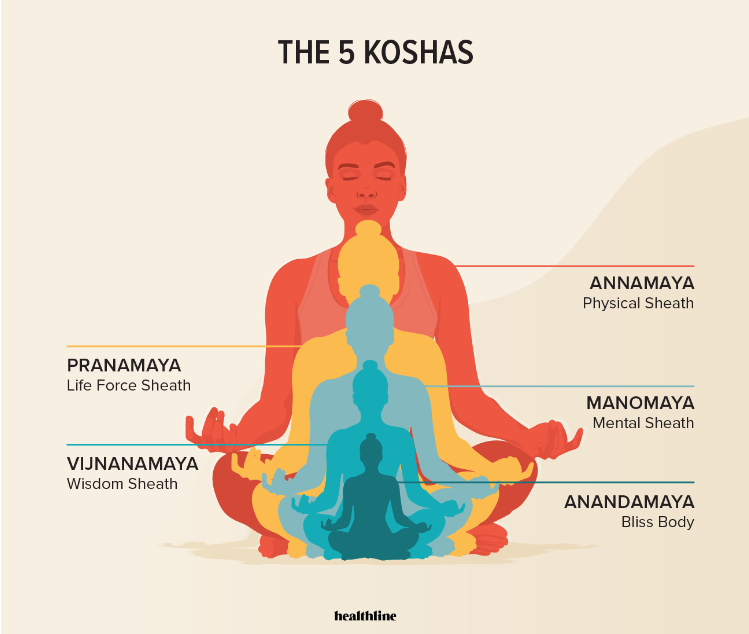It’s widely accepted that yoga can improve flexibility, balance, and strength as well as cultivate mental clarity and a sense of calm. However, this is just scratching the surface of what the practice of yoga entails.
Yoga, at its core, is a comprehensive and holistic approach to physical, emotional, and mental wellbeing. When practiced fully, yoga goes beyond addressing the physical body and delves into the five energetic layers of the body. It is believed that for true healing to occur, you must look beyond the physical and explore your koshas.

What is a Kosha?
In Sanskrit, the word kosha means “sheath” or “layers” and refers to the five energetic bodies, one encased by the next, that comprise your entire being. The koshas are all interwoven and can not be separated; what happens on one level affects all layers of the body. Meditation is a great tool to help explore your koshas and turn your attention away from the physical and toward the spiritual for a deeper understanding of your innermost self.
Similar to the chakra system, the kosha layers come packaged with their own physiological function and deeper psychology. They provide a framework for understanding yourself better and conceptualizing your spiritual core. Many believe that attention to the koshas may awaken a deeper state of awareness on the path to self-realization. That’s a tall order so let’s explore each kosha more deeply.
The 5 Koshas
Start by visualizing the five koshas surrounding the soul as layers of an onion, or like Russian nesting dolls that contain increasingly smaller versions of itself as you move inward. The koshas start from the outermost layer with the physical body followed by the energetic and mental bodies. These are the three koshas most explored through yoga and meditation. From there, you travel inward further to the wisdom body and the bliss body.
Annamaya
The annamaya kosha represents the physical body including the skin, muscles, bones, connective tissue, and fat. When you pinch your skin and feel the muscles and tissue between your fingers you are engaging with the annamaya kosha. For most, this first layer is where we spend the most time, locked in our physical senses.
Pranamaya
The pranamaya kosha is the vital energy, breath, or life force sheath and represents the subtle body. It also controls the movement of blood and lymph through the circulatory system and the movement of breath through the respiratory system. You may be familiar with the word “prana” from yoga class as it is the Sanskrit word for breath. Tapping into this kosha enables you to move stagnant energy and find a deeper connection to both yourself and others.
Manomaya
The manomaya kosha is the third energetic layer which moves you deeper into the recesses of the mind and nervous system. This kosha acts like a messenger, ushering experiences from the physical world into your intuitive body. This mental sheath represents your mind, emotions, and inner world and starts to bridge the gap between your outer and inner worlds and invites you to examine your mental patterns. This is the layer where you begin to move from the physical realm to that of emotional feeling where you can start to tap into your intuition.
Vijnanamaya
The fourth layer is known as the awareness or wisdom sheath. It is your psychic body and the seat of intuition which enables you to develop a deeper awareness of what actually is. The vijnanamaya kosha helps you cultivate clarity as you detach yourself from your thoughts or ego. By simply witnessing your thoughts, and not reacting or attaching meaning to them, you become more present and aware of each moment. Here, you are able to understand that you have a choice in all things and can choose to react with intention or to move past the emotion into bliss.
Anandamaya
The fifth kosha is referred to as the bliss body where you may experience liberation from suffering and a deep sense of connectedness with all things. Learning to access this kosha requires a dedication to spiritual practices and inner work over a long period of time; the anandamaya kosha is not something you drop into on a whim.
Commitment to your yoga practice will help you access the deeper, more subtle kosha layers. The physical asana practice and breath work helps prepare your outer body and, through yogic philosophy and meditation, you may be able to bring awareness to your true spiritual self.
Want to learn more about the Koshas and other aspects of vedic philosophy? Grab our 8-days free Intro To Yoga Teacher Training series and get a daily email diving deeper into these concepts.